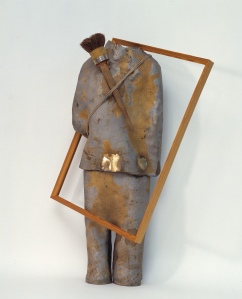Reflecting Prerequisites to Co-creation – the #moodleMOOC begins!
I’m sharing an a-HA moment experienced during my recent Encounter Art Facilitator studies. – Co-creative learning indeed produces more than the sum of each learner’s individual input. The extra we see does not appear from nothing though. When we learn and work together collaboratively and connected it’s a privilege to perform more than what we would when learning or teaching alone. The other side of the coin is that we are also forced to do more. The whole does not progress without each and every participant performing some extra work – at times this means not only some extra learning efforts, but big learning efforts. This extra required of us does not happen without dedicated time, space, support, care… That’s why during a MOOC – or actually during any co-creative learning setting – the personal learning process plays an extremely important role. The personal process can be separated and very different from what we share collectively. Successful personal processes of each individual learner are prerequisites to the whole we expect to achieve. This is how I currently perceive the personal process – these eight elements belong to a learning day of a MOOCer:
The dialogue of learning processes is one issue I’d like to reflect more during this MOOC. Have you got similar experiences? Or totally different? Why might that be?
I’m very much looking forward to proceeding to the first #moodleMOOC week!
[CC photos: http://www.flickr.com/photos/connectirmeli/sets/72157633859210106/]
Beginning the 1st week of the #change11 MOOC – preparing for refractions and unprocesses
I just changed the name of my blog to: On the fourth Identity. This post is my first rough plan for explaining what I’m aiming to develop around this topic and why I chose to make the #change11 MOOC my main utility and vehicle for the next 36 weeks. There are three main points. As the first I’ll mention the first Aboagora symposium held in Turku, Finland a month ago. The theme was: Rethinking enlightenment. Putting the concluding message of the first Aboagora in brief – we must teach our children that we’ve made the world a place in which no-one can predict what kind of impact the development of all the technology next will have on us. We must learn to adapt. We must learn to do it together. Refraction instead of reflection and re-inventing are key words.
As the second point I pick up this blog post by George Siemens explaining the #change11 process: “The final image, however, is one that will be formed by all of our contributions!”. So it will be all about re-inventing – not getting stuck with endless reflection, but utilizing the refractions brought by the diversity of interests and being open to changing the direction along the way and not setting too fixed targets at any phase of this MOOC.
“Believe that there’s light at the end of the tunnel. Believe that you might be that light for someone else.”
– Kobi Yamada – photo: cc Irmeli Aro’s flickr 2011/365/255
The third and my most personal reason goes back to an afternoon class in February 2004. I had started to work for a R&D European Union Socrates programme Minerva project on inter-cultural education. The first task was to participate & learn to tutor the pilot courses belonging to the project. The main knowledge architect of the project Venla Varis explained that in order to become an inter- and socio-culturally competent educator, manager, learner and knowledge worker we must learn a second, third and even a fourth identity. – The project ended in 2005. No next project followed. There’s been a small group of us enthusiasts who have kept the idea of the next identities as a back light of all our learning & development ever since. Now I feel I’m ready for both myself learning the fourth identity and collaboratively collecting the learning process from the first identity to the fourth as a transformative learning path – to be tested as a model for e.g. learning & coaching organizational dialogue as the following step. The following conference paper by Venla Varis presented in Prague in 2005 (the International Conference New Perspectives in Cognitive and Inter-cultural Learning: from Preschool Education to Information Society) explains the outcomes of the mentioned EU project: Sociocultural competence and its evaluation. I’m going to both summarize and expand the theme throughout this MOOC.
How I’ve personally experienced the identities I-III so far
By yesterday, exactly ten years ago, I had used almost fifteen years of my young adulthood for expanding my career within airline ground handling subcontracting services. I was a member of a global innovation project group. We aimed at re-inventing the branch. The growth expectations were exceptional compared to many other businesses. An intriguing future was just around the corner. Today, exactly ten years ago, we were reading of the devastating effect the New York bomb attacks would have to our business. Very soon the UN International Labor Organization estimated that almost a million jobs were lost overnight within the airline and travel business and related services. And that was only a beginning of the snowball effect which followed. All innovation projects were canceled. The recession was a kick-off for focusing on cutting costs only. For us who – despite our still relatively young age – considered ourselves to be old professionals within the business in concern, the further career doors were closed for ever.
Observing the case now – it had never ever occurred to us that our competences were extremely bound into a very narrow context. We considered ourselves to be able to form and conduct multicultural teams and to innovate and re-invent. We were totally blind to the fact that our skills were limited to performing inside thick walls of the existing old silo only. In brief – in the end of the day, there was always someone more experienced to say something like …good ideas you have, but that kind of ideas have never worked before – so let’s not touch the corner stones of our activities. – When we became redundant, we had no preparedness to re-invent anything outside the safe walls of the closed old silo. Neither had it ever occurred to us that a major part of the core network of (professional) friends would get unemployed simultaneously. All of a sudden we were not able to offer any kind of professional help or safety network to each other.
Acquiring the second identity
For acquiring the next identity (which process I of course at that time could not name or understand like that) I started to study forestry economy. The above mentioned EU project was one side path of my studies. The main outcome of the project and its courses for me personally was a completely new way to interpret personality tests. I had taken several of them during my earlier career – and always the results had been explained more or less in a way that emphasized a point view according to which we were supposed to remain the way we were. What can be done is to transfer people into different job positions. There was always a dose of fear in the air when hearing the test results. – What if I’m not a suitable personality for my current job position… We completed the DiSC test during the EU project. For the first time ever I got the result explained in a way that the test points out two personality types you kind of know because of how you were born, raced and later on socialized into at school, during studies, at job organizations etc. How you should utilize the result is that you should planned and consciously begin to practice the two personality types you cannot utilize e.g. in multi-cultural contexts yet. I’ll go deeper into how the process proceeded later on. As a brief conclusion I can say that because of starting to practice the Steadiness and Influence pillars of DiSC – I’m writing this post here today. The “S” and “I” can also be thought to stand for “social” and “innovative” – skills we did not get any real chances to practice inside the old working silo with the thick walls.
photo cc Irmeli Aro’s flickr @dailyshoot #ds609
Observations of the process of learning the third identity
Acquiring the third identity began when I participated my first MOOC: Connectivism and Connective Knowledge #cck08. When looking back today – I realize that no matter how crucial I still keep the phase of learning the second identity for my whole life – I actually during that time learned two new silos inside which I acted from. The new silo #1 was the forestry economy. During the years we completed the B.Sc. a significant amount of Finnish forestry and pulp industry moved into areas where the near future core markets are: Brazil, China, Russia… The process still continues. The old plants are closed one after another. – Again – no matter if we are old professionals or newly graduated – we have no readiness to re-invent, when the old safe silo with the old safe procedures does not exist any more. My new silo #2 was e-learning. Through the before mentioned EU project inter-cultural education became my minor subject and I completed my bachelors thesis on transformative web learning of adult students. I also completed web teacher studies. But, but… the core ideas I had adopted were that it’s up to the teacher or tutor to create an authentic learning environment, collect clear instructions, be a lot present throughout the course and always correct, aid and/or decide how to proceed if any problems occur within the e-course work. But hey… that sounds like the teacher builds a safe silo with thick walls for the duration of the course… It may work well for a learner who has her or his old work silo where to return and utilize all the learned. – Again I was in a situation in which I had no readiness to re-invent outside an old learning silo with the thick old walls. Sigh.
MOOC is about sharing your local contextualizing process globally
Many pieces of the identity reconstruction puzzle fell into there places on last Friday when an entrepreneurial meet-up 71. #bisnestreffit (in Finnjsh) coordinated by TIEKE (Finnish Information Society Development Centre) was organized in Helsinki with strong social media presence. The topic was open public data. Among the conclusions were at first, that even though our new government supports the process, a clear political leadership and will is missing, and second that a big reason why organizations in key positions to take the remarkable steps forward don’t do it – is that people throughout the organizations are stuck with 2D A4 paper sheet kind of imagination. Yes!
Finnish entrepreneurial coach and author Mari Aulanko has taught that if we try to improve our (working) life by changing the context (like moving the location, organization…) our worries, troubles and sorrows follow and move behind us. This is what happens if and when we see a MOOC to be our next or new context for learning. The focus is not in the center of the MOOC itself. Our focus must be in re-inventing our closest contexts and sharing the process with other MOOCers and learning and daring more by utilizing each others’ experiences.
And next into discovering the first refractions of this MOOC
My whole post has been about good old old-fashioned reflection. What I’ll do next is start to find out what you other participants are aiming at. I don’t intend to make too fixed goals for learning & development in the beginning of the MOOC – but I’ll anyway draw some outline for the discoveries I’d like to have made by the end of next May. Some of my current key issues are:
- utilizing blogging, concept mapping etc. during this MOOC to draft a publication on “The Fourth Identity” (together with Venla Varis) – I don’t want to decide the exact format yet
- utilize an unconferencing process called #SomeTime2012 for organizing a series of workshops bound to this MOOC in Finland during the next spring
- based on the above, decide the final perspective for my master’s thesis on new knowledge management
- bind the above process with the unprocesses of opening the public data in Finland <= find some (un)organizations willing to test & develop the MOOC & identity reconstruction processes & procedures
Now I’m very curious how all your inputs will shape and refine my list by the end of this week!
#edfutures Succeeding in turning my MOOC learning curve the other way around?
It’s the beginning of the week 4 of 8 of #edfutures course. I’m almost ready to become fully visible. I’ve been lucky to participate to #cck08 and and some other MOOC:s (massive open online course) after that. Based on the experiences gained, I try to turn my learning curve the other way around this time. During the previous MOOC:s I’ve been either active or very active in the beginning of the course. The beginning of an e-learning course traditionally means presenting oneself and getting the discussions going. When a MOOC is in concern, it means a million messages in discussion forums. And then another million. Because the majority of us participants still thinks according to the way the courses used to be, we try to say everything of everything immediately. A third million of messages.

 Photo cc Irmeli Aro’s Flickr
Photo cc Irmeli Aro’s Flickr#cck09 #eci831 From Intuition to Innovation – Introducing myself
When I started last year’s first version of Connectivism and Connective Knowledge Course, I faced two very confusing things. The first one culminates in this slide #5 belonging to a presentation created by George Siemens: “Helsinki Seminar”.
 Picture: Slide #5 by George Siemens: “Helsinki Seminar”
Picture: Slide #5 by George Siemens: “Helsinki Seminar”
It was very difficult to begin to perceive that organization scheme 2.0 looks like the August flower in the following picture.
 Picture: Irmeli Aro’s Flickr
Picture: Irmeli Aro’s Flickr
…That one of the nodes is me. That knowledge emerges in the network: The new knowledge already exists somewhere there in the background, invisible, tacit, even hidden …waiting for becoming discovered, made visible, usable, combined in a new way, growing into innovations and sustainable solutions. Helping your organization to learn to collaborate, create, gradually reduce stress and boost well-being. That this is the way the world 2.0 around us already looks like. That the networked era already has began. That “the node-thinking” is a way, means and tool not only to manage and cope but to transform your learning and distribute this attitude – beginning from your closest surroundings and the effect gradually growing into new dimensions.
The second confusing thing was the overwhelming amount of social media tools I should learn to take into daily use. That was as unfamiliar for me as the above described “node thinking”.
Ton’s Interdependent Thoughts offered a huge help for my connective learning – in an intuitive level. Prior to the beginning of CCK08 Ton had included in response to my post to CCK08 Google Group – something I today would say is:
“Ten Rules of becoming a Social Mediator”
-I needed to learn to make sure there is enough diversity, dissent, breadth and depth in my social network for it to work as an information filter.
-I needed to learn how to avoid echo-chambers.
-I needed to learn that context is often the most important information.
-I needed to learn to measure my actions in a meaningful way, the stuff that I did do, not the stuff I could have done.
-I needed to learn to switch faster between contexts. And at the same time create enough space of focus to do stuff, not just switch all the time (like people checking their e-mail 60 times an hour).
-I needed to embrace uncertainty, and see linear problem solving as something that has its own niche of application (Like Newtonian physics has its own niche, compared to relativity theory.)
-I needed to learn complexity theory.
-I needed to learn to focus on big pictures (patterns) and minor details (my personal single actions) at the same time.
-I needed to learn to be connected and empathic on a global scale, and be deeply rooted in my local community at the same time
-I needed to learn to formulate my core values, strong beliefs, deep wishes and dreams, as a basis for choosing actions in the moment.
From learning by doing to doing by learning – from intuition to innovation
CCK08 networked learning boosted my learning by doing. Encouraged by the example and peer support of my growing network I added a small element to my 2.0 tool box every day. I understand and recognize now that it was the only way to find, create and recreate my own learning space – my path within the nodes toward the new emerging networked way of thinking and working. Even though it at times felt very stressful. Instead of learning stricktly as instructed – choosing which kind of knowledge, information and competence to produce and share by oneself.
In a year’s time of active sharing and deepening my network, concrete changes started to happen. I’ve been involved in development process of Holistic Cultural Competence Assessment (HCCA) Learning Model since the corresponding EU Socrates/Minerva Project ended in 2005. The Learning Model looks as follows in a pre-2.0 phase:
 HCCA Learning Model in pre-2.0 phase (Picture: Irmeli Aro’s Flickr)
HCCA Learning Model in pre-2.0 phase (Picture: Irmeli Aro’s Flickr)
Finding partners for furter developing the HCCA Model has been very difficult in Finland. I’m currently translating the HCCA Model in Finnish and to reflect my working process I started a blog in Finnish a couple of weeks ago. To my surprise I’ve already got remarkable contacts expressing there interest in HCCA Model. This is due my blog posts circulating withing several social networks – reaching people I’m not aware of and I never would have reached without social media tools.
My learning by doing phase is now transforming into doing by learning phase. I’m in transition. My home country is in transition. These phases resonate. This is what I meant by the chain I mentioned in my video: Learning initiave by Canadian teachers –> knowledge and competence emerging in an active global learning network –> boosts innovation in Finland.
My biggest goal for #cck09 and #eci831 is to learn more of how to encourage people to dare to try social media tools, to learn to let one’s imagination fly. With my photo of the day 2009/258 I wish us all blue skies and innovative surprises for the beginning fall – and spring for the classmates down under 🙂
 Phot0: Irmeli Aro’s Flickr
Phot0: Irmeli Aro’s Flickr
Welcome to the 2nd World Summit on the Knowledge Society
Dear All,
We are happy, to invite you to participate in the 2nd World Summit on the Knowledge
Society, which will take place in the heart breaking city of Chania, in the exciting island of
Crete in Greece. More information available at: http://www.open-knowledge-society.org/summit.htm
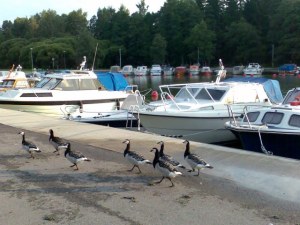
For three days, 140 papers will be presented covering all the aspects of the Knowledge
Society, towards the vision for a better world through the exploitation of Emerging
Technologies and Systems, in the context of social and humanistic themes and objectives.
Registrations are open at a special rate for attendees. Please contact the conference
secretariat, for more information at wsks2009@otenet.gr, Att. Mrs Katerina Pitsa.
We are looking forward to see you in Chania,
http://www.flickr.com/search/?q=chania%2C+crete and to explore together exotic
places in the sea and the mountains of Crete, like
Balos, http://www.flickr.com/search/?w=all&q=balos+crete&m=text
Elafonisi, http://www.flickr.com/photos/wolfgangstaudt/925257946/
Falasarna, http://www.flickr.com/search/?s=int&w=all&q=falasarna&m=text
Samaria, http://www.flickr.com/search/?s=int&w=all&q=samaria+crete&m=text
We are sure you will be excited in WSKS 2009, Join us today.
There are also still many options for contributing to the Scientific Program of the Summit,contributing your research work. Please contact Directly Dr. Miltiadis D. Lytras at miltiadis.lytras@gmail.com.
The Official WSKS 2009, proceedings consist by two volumes of: Springer LNCS/LNAI, LNAI 5736 entitled:
ISIONING AND ENGINEERING THE KNOWLEDGE SOCIETY : A WEB SCIENCE PERSPECTIVE – A BOLD RESPONSE TO THE MULTIDIMENSIONAL ECONOMIC, SOCIAL, AND POLITICAL CRISIS OF OUR TIMES,
Miltiadis D. Lytras, Ernesto Damiani, John M. Carroll, Robert D. Tennyson, David Avison, Ambjorn Naeve, Adrian Dale, Janice Sipior, Felix Tan, Paul Lefrere, Gottfried Vossen (eds)
and Springer CCIS 49
BEST PRACTICES FOR THE KNOWLEDGE SOCIETY: PROMOTING THE DIALOGUE FOR SUSTAINABLE DEVELOPMENT AND A BETTER WORLD BASED ON KNOWLEDGE, LEARNING, DEVELOPMENT AND TECHNOLOGY FOR ALL
Miltiadis D. Lytras, Patricia Ordonez De Pablos, Ernesto Damiani, David Avison, Ambjorn Naeve, Dr.David G. Horner (eds)

YOU CAN STILL CONTRIBUTE TO THE RESEARCH PRESENTED IN WSKS 2009. Submit your paper ASAP. More info below:
There are 20 special issues in International Journals, related to the KNOWLEDGE MANAGEMENT AND TECHNOLOGY ENHANCED LEARNING SYMPOSIUM
in the context of the 2nd WORLD SUMMIT ON THE KNOWLEDGE SOCIETY, WSKS 2009
16-18 September, Crete, Greece http://www.open-knowledge-society.org/summit.htm
The 2nd World Summit on the Knowledge Society and the International Journals:
1. International Journal on Knowledge and Learning,
http://www.inderscience.com/browse/index.php?journalCODE=ijkl
2. International Journal on Technology Enhanced Learning,
http://www.inderscience.com/browse/index.php?journalCODE=ijtel
3. International Journal of Knowledge Society Research,
http://www.igi-global.com/journals/details.asp?id=34715
Co-sponsor the KNOWLEDGE MANAGEMENT AND TECHNOLOGY ENHANCED LEARNING SYMPOSIUM, which will be organized in the context of the 2nd World Summit on the Knowledge Society. The aim of the symposium is to reveal the emerging research agenda and the scientific contribution of Knowledge Management and Technology Enhanced Learning Domains towards the vision of the Knowledge Society.
PUBLICATION PROCESS
A special process for contributing to the symposium has been designed:
Submissions are invited in the context of 14 special issues that will be published in the
sponsoring journals within 2009 and 2010. All the accepted papers must be presented in
the 2nd World Summit on the Knowledge Society. Authors will have the options:
1. To publish a short version of their paper in the WSKS 2009, post-conference proceedings
and the extended version [revised at least by 40%] in the relevant special issue
2. To publish their paper directly in the Sponsoring Journal’s special issue.

SUBMISSION PROCESS
Use the relevant template, and submit your manuscript through the WSKS 2009,
submission system available at: http://www.easychair.org/ with a copy at
wsks2009@otenet.gr indicating the Special Issue for which your paper is submitted
IMPORTANT DATES
Submission of short version of papers: 25th August 2009
Notification to authors: 30th August 2009
Camera ready papers [short versions for WSKS 2009 proceedings]: 5th September 2009
Camera ready papers [for sponsoring journals special issues]: 15th October 2009
Conference Days: 16-18 September 2009
THE AGENDA OF THE SYMPOSIUM
RESEARCH TOPICS WITH PRACTICAL SIGNIFICANCE FOR THE KNOWLEDGE SOCIETY
SPECIAL ISSUE ONE: THE SOCIAL WEB: WEB 2.0 AND SOCIAL NETWORKS RESEARCH FOR KNOWLEDGE MANAGEMENT AND E-LEARNING
Publication outlet: INTERNATIONAL JOURNAL OF KNOWLEDGE AND LEARNING [Volume 5, Issue 5, 2009], http://www.inderscience.com/browse/index.php?journalCODE=ijkl
The main objective of this special issue is to bring together researchers, practitioners and academics with sound propositions and novel approaches for the exploitation of social networks research in the context of the social web and its application for knowledge management and learning.
Topics include, but are not limited to, the following:
* Design variables and conditions for social networks
* New forms of interaction in social systems
* Blogging as a social activity and approaches to semantic blogs
* Collaborative filtering in social settings
* Analyzing social interaction for finding knowledge on Web users
* Semantic Desktops
* Social Network Analysis enabled by the Semantic Web
* Learning and Knowledge Communities
* Analysis of Large Online Communities Web Communities of Practice
* Network Analysis for Building Social Networks
* Implicit, Formal, and Powerful Semantics in Communities
* Semantic Social Networks Metadata and Annotation Techniques
* Metadata schema describing individuals and social ties
* Folksonomies, tagging and other collaboration-based categorization systems
* Wikis, semantic Wikis and other collaborative knowledge creation systems
* Online Social Networking
* Applications of Online Semantic Networks
* Knowledge Management with Semantic Networks
* Emerging Human Experiences in Social Networks
* Analysis of Human Behaviour in Semantic Social Networks

SPECIAL ISSUE TWO: KNOWLEDGE MANAGEMENT STRATEGIES: EMERGING TECHNOLOGIES, APPLICATIONS, SYSTEMS AND PRACTICAL IMPLICATIONS
Publication outlet: INTERNATIONAL JOURNAL OF KNOWLEDGE AND LEARNING [Volume 5, Issue 6, 2009], http://www.inderscience.com/browse/index.php?journalCODE=ijkl
Knowledge management has been used as a high-promise business concept. In an era of business transition, the effective management of knowledge is proposed as a strategy that exploits the organizational intangible assets. However, the term of knowledge management has been used in order to describe many different applications. In some cases the tag of ‘knowledge management product’ is attached to several software programs purely for marketing reasons.
We recognize knowledge management as a socio-technical phenomenon where the basic social constructs such as person, team and organization require support from ICT applications. The ultimate objective of the special issue is to provide practical guidelines for applied knowledge management through the discussion of specific technologies.
For this reason we invite submissions that discuss a specific Knowledge Management Strategy which is fostered through the employment of emerging technologies.
The two key questions that will be answered from the overall special issue are:
* Which technologies to use for specific KM problems?
* Which strategy can guide the implementation of KM that corresponds to the application areas?
Application areas include, but are not limited to, the following:
ARTIFACT LEVEL
* Managing Documents
* Managing Metadata and Semantics
* Managing Taxonomies
INDIVIDUAL LEVEL
* Constructing Yellow pages of experts
* Managing individual profiles
* Managing Tacit Knowledge
TEAM LEVEL
* Managing Workflows
* Managing Discussion Forums
* Exploiting Collaborative Work Systems
* Managing Team Dynamics
ORGANIZATIONAL LEVEL
* Building Best Practices
* Developing Knowledge Maps / Ontologies
* Managing Competencies
* Managing Organizational Memory
INTER – ORGANIZATIONAL LEVEL
* Managing inter-organizational network
* Managing Projects
* Future Technologies
SPECIAL ISSUE THREE: PERSONALIZATION AND CONTEXT AWARENESS FOR HIGH EFFECTIVE KNOWLEDGE AND LEARNING SYSTEMS Publication outlet: INTERNATIONAL JOURNAL OF KNOWLEDGE AND LEARNING [Volume 6, Issue 1, 2010], http://www.inderscience.com/browse/index.php?journalCODE=ijkl
SPECIAL ISSUE FOUR: KNOWLEDGE MANAGEMENT AT LARGE SCALE: Knowledge Management Cases for the Businesses, Organization and Government. Publication outlet: INTERNATIONAL JOURNAL OF KNOWLEDGE AND LEARNING [Volume 6, Issue 2, 2010], http://www.inderscience.com/browse/index.php?journalCODE=ijkl
SPECIAL ISSUE FIVE: ENTERPRISE APPLICATION INTEGRATION AND ERPs: BUSINESS INTELLIGENCE THROUGH ADVANCED KNOWLEDGE MANAGEMENT Publication outlet: INTERNATIONAL JOURNAL OF KNOWLEDGE AND LEARNING [Volume 6, Issue 3, 2010], http://www.inderscience.com/browse/index.php?journalCODE=ijkl

SPECIAL ISSUE SIX: MICROLEARNING AND MICROCONTENTS Publication outlet: INTERNATIONAL JOURNAL OF TECHNOLOGY ENHANCED LEARNING [Volume 2, Issue 4, 2009], http://www.inderscience.com/browse/index.php?journalCODE=ijtel
SPECIAL ISSUE SEVEN: TECHNOLOGY ENHANCED LEARNING CASES: DEMONSTRATION OF HIGH EFFECTIVE E-LEARNING SYSTEMS AND PROJECTS Publication outlet: INTERNATIONAL JOURNAL OF TECHNOLOGY ENHANCED LEARNING [Volume 2, Issue 4, 2009], http://www.inderscience.com/browse/index.php?journalCODE=ijtel
SPECIAL ISSUE EIGHT: TECHNOLOGY ENHANCED LEARNING CASES: DEMONSTRATION OF HIGH EFFECTIVE E-LEARNING SYSTEMS AND PROJECTS Publication outlet: INTERNATIONAL JOURNAL OF TECHNOLOGY ENHANCED LEARNING [Volume 3, Issue 1, 2010], http://www.inderscience.com/browse/index.php?journalCODE=ijtel
SPECIAL ISSUE NINE: E-LEARNING PEDAGOGY: REVISITING THE LEARNING MODEL THROUGH ADVANCED LEARNING STRATEGIES. Publication outlet: INTERNATIONAL JOURNAL OF TECHNOLOGY ENHANCED LEARNING [Volume 3, Issue 2,2010], http://www.inderscience.com/browse/index.php?journalCODE=ijtel
SPECIAL ISSUE TEN: INNOVATIVE TECHNOLOGY ENHANCED LEARNING SOLUTIONS: BEYOND THE STATE OF THE ART Publication outlet: INTERNATIONAL JOURNAL OF TECHNOLOGY ENHANCED LEARNING [Volume 3, Issue 3, 2010], http://www.inderscience.com/browse/index.php?journalCODE=ijtel
SPECIAL ISSUE ELEVEN: THE TECHNOLOGY ENHANCED LEARNING RESEARCH DOMAIN: A CRITICAL REVIEW OF THE LITERATURE Publication outlet: INTERNATIONAL JOURNAL OF TECHNOLOGY ENHANCED LEARNING [Volume 3, Issue 4, 2010], http://www.inderscience.com/browse/index.php?journalCODE=ijtel
SPECIAL ISSUE TWELVE: KNOWLEDGE SOCIETY: STRATEGIES, GOVERNMENTAL INITIATIVES, APPLIED RESEARCH: TOWARDS THE GLOBAL KNOWLEDGE SOCIETY Publication outlet: INTERNATIONAL JOURNAL OF KNOWLEDGE SOCIETY RESEARCH [Volume 1, Issue 2, 2010], http://www.igi-global.com/journals/details.asp?id=34715
SPECIAL ISSUE THIRTEEN: FUTURE PROSPECTS FOR THE KNOWLEDGE SOCIETY: FROM FORESIGHT STUDIES TO PROJECTS AND PUBLIC POLICIES Publication outlet: INTERNATIONAL JOURNAL OF KNOWLEDGE SOCIETY RESEARCH [Volume 1, Issue 3, 2010], http://www.igi-global.com/journals/details.asp?id=34715
SPECIAL ISSUE FOURTEEN: SUSTAINABLE DEVELOPMENT OF THE KNOWLEDGE SOCIETY: NATIONAL, REGIONAL AND INTERNATIONAL PERSPECTIVES Publication outlet: INTERNATIONAL JOURNAL OF KNOWLEDGE SOCIETY RESEARCH [Volume 1, Issue 4, 2010], http://www.igi-global.com/journals/details.asp?id=34715
More information on the Special Issues:
Request from General Chair of the WSKS 2009, Dr. Miltiadis D. Lytras,
miltiadis.lytras@gmail.com
#CCK09 Passing the next starting line of sharing learning connectivism :)
The following picture visualizes well how the beginning of learning connectivism feels for the learner. The traditional learning skills focus on affecting / curing / caring for the visible part – whether we call it a problem, need, opportunity, chance, dilemma… When learning the traditional way – nothing changes, nothing new really happens after the official learning part ends.
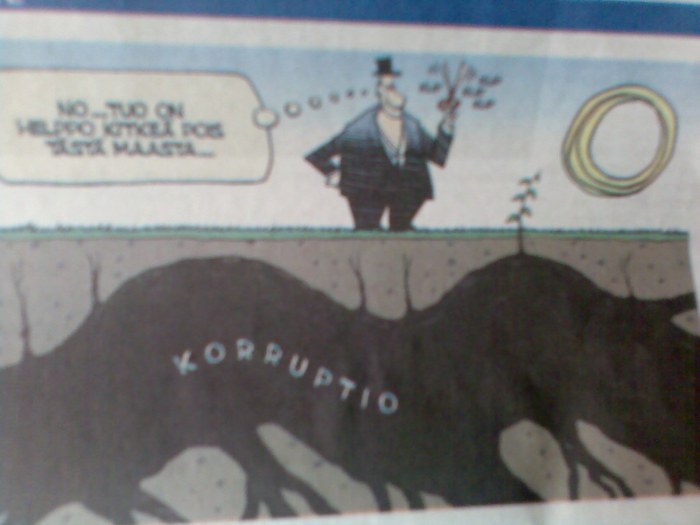
The original Finnish text of the above picture says: “Well, that one will be easy to tear up…” (It visualizes corruption, but according to my current experience of and competence on learning, it forms a suitable metaphor for connectivism – and (trans)cultural learning in general! – as well. Connectivism is special because the start-up phase grubs the soil, even digs in the ground deep enough in order to begin to make the rootstock visible. Because the rootstock has been unvisible for year and years – learned without reflection, never unlearned – the start-up phase boosts feelings of learning like: Disorienting dilemma, cognitive overload, complete chaos… What is good and even unique in this process is that it really boosts conscious unlearnng; revealing great fresh new soil for – LEARNING!!! This is how and why connectivism is the means of (organizational) learning for this and the next decades.
After having lived the chaos learning for a year and really feeling full of collaborative energy when now passing the treshold to next challenges – what has brought me here and brought me all the energy is the amazing network of co-learners who have gatherer around me. Without you nothing of this personal learning process would have been possible. Thank you. Every one of you. From the bottom of my heart.
As a concluson of my personal learning experience so far: The connective theory is lifewide, holistic and transformative. It demands giving your everything. But because the connective learning process boosts network processes, the mutual benefits get multiplied compared to the amount an invidual gives and shares, aids and cares.
Much, much more difficult and demanding than diving into the connective theory has been learning a completely new way of studying –> working –> living by shared learning. Adopting applications like WordPress, Flickr, Twitter, Picasa, Facebook… – I would say – is less than 5% of the whole needed to be learned prior to being able to begin to put connectivism into practice. More than 95% of the learning consists of the 21st century competences of shared learning.What has been most new and different from all studying, working… cultures I’ve experinced before is that in a connective context there’s always someone to help you! Reaching this point needs conscious effort on working on your competence on critisism and openness, enthusiasm and fears, diving deep and being cautious… That’s why it takes more than 95% of your learning – in the beginning. These are skills and competences needing repeated practice and unlearning – something that never has been recognized in the cultures I’ve experienced before.
The above A-HA experience is my lead idea in front of Connectivism and Connective Knowledge Course CCK09 –> distributing this knowledge in practice – and beginning within my own closest culture and surroundings. This month will be time of gathering key themes learned so far – for deepening and sharing them during CCK09. Having reached this point feels very good. Looking forward to meeting all of you – old and new CCK fellow learners :).
(Source of the picture: Photographed from Finnish Newspaper Länsiväylä, August 1-2, 2009 issue, page 14. The drawer uses alias ‘JOKE’.)
Sharing my spirit of preparing for the New Year
May we learn to reflect new occasions back to our network members and nodes of knowledge in unexpected and surprising ways – to learn to see the light changing, transforming, emerging happiness…
All the best for the New Year 2009!!
Irmeli
“Changing Light” by Kaija Saariaho:
CCK08 Understanding Self (Connective Behaviour in Practice, Part 1/8)
The theme of the beginning new week 9 of the CCK08 Connectivism and Connective Knowledge course is: “What becomes of the Teacher – New Roles for Educators”.
According to the Learnscape Sandbox Team: “Curriculum-free, interactive and self-service learning is the way of the future: Ecologies where work and learning are one and the same, where people help one another build competency and master new crafts, where members of self-sustaining communities of professionals participate because they take pride in maintaining their standards and doing a great job, and where everyone strives to be all she can be. Open, participative, bottom-up, networked, flexible and responsive learning – that’s what we’re after.”
Dave Pollard has collected a comprehensive list from the contents of his blog posts perceiving answers to the question: “In a world with a billion people online, connected in multiple and unfathomably complex ways, how do you find, and then connect, with just the right people to do what you need to do:
1 ) Know yourself well, so you really know what you’re looking for in a partner (in enterprise, in community, or whatever). You can’t find the right people until you know what you’re looking for. 2 ) Get attention by saying or doing something important or interesting. Articulate an unrecognized need or a creative idea or a provocative possibility or an intriguing offer. Do something bold and imaginative. Make something truly novel that the world needs (a prototype will do). This is not easy, but if you can get people’s attention, you are more likely to have the people you need to find, seek you out and connect with you. 3 ) Craft an invitation. Write up something compelling and send it out to as many people as possible, asking them to forward it to others. The people who accept your invitation will be the right people. 4 ) Get out there and have a lot of conversations and collaborations. Sometimes you have to kiss a lot of frogs before you find a prince. So join groups that will expose you to people with common interests, and converse and work with their members. The more people you talk with, seriously, about things that matter to you, the more people you are likely to find who share your passions and your purpose — the people you are meant to make a life or a living with, or just work together with on an important project. 5 ) Be loving and generous. Great collaborations and partnerships have great chemistry. Open yourself up to that chemistry, and let others know you are open to it. 6 ) Be attentive. The people who can make a difference in your life, on your project, and in the world are often not the people you would expect. Listen, watch, feel what’s being felt but not said, draw people out. 7 ) Seek diversity. The wisdom of crowds demands diverse perspectives, ideas, ways of thinking. Echo chambers are terrible places to generate new ideas and ways of thinking. 8 ) Draw on the strength of weak links. The people you seek may well be two or three degrees of separation from the people in your immediate networks. Ask the people you know who they know that fit what you’re looking for.”
Thank you Dave for providing me a frame of reference for the last third of the CCK08 course! This post begins a series of blog posts describing in practice, how I have changed my thinking in order to learn a connective way of behaving i.e. experiencing a transformation into a connective person. During the remaining four weeks of the CCK08 course I’ll create two posts a week, following the above procedure (1-8) listed by Dave – this first post is dealing with 1 ) “Know yourself well”.
According to Saarinen & Hämäläinen (2004, 13) the change required when learning e.g. the modeling of complex systems as well as the mathematical models of decision making, competition and cooperation consists of the following four dimensions: Mental change => Perceptual change => Individual behavioural change => Change in the system. Here’s how I see my mental change towards a connective personality illustrated in seven pictures.
Picture 1: May 2004
As a part of an assignment belonging to my studies of natural resources, I was asked to illustrate my favourite landscape. I chose a picture from North Norway – like the above one I found in VirtualTourist today – and added some Indian wisdom: Among all tribes of our people there’s a learning according to which it’s essential to find a quiet place – in the middle of bare mountains, in the desert or by the see in order to increase understanding of the direction of the creation. We are all aware of the power of the prayer strengthening our senses, the fast, sweating and other meditative ways which help us become pure and prepare the spirit and soul to hear the voice of the holy secret. (Akwesasne – I only found this in Finnish, the translation is my free interpreting).
Picture 2: October 2006
I became conscious of this phenomenon – how my current competence to learn can be put in form of a picture in my mind – when I was writing the first draft of my Bachelor’s Thesis. This happened almost two and a half years after having completed the above mentioned assignment – which was the first of a kind, when I was asked to prune my thinking with help of choosing a picture. This second time was not connected to any actual assignment. I was collecting source material regarding transformative learning. I was reflecting ideas of how creating a multi-cultural learning environment is like building a bridge – how it really resembles a true complicated constructing process of an actual bridge. I could see a clear visual image of my favourite landscape – a scenery – in my mind. It was full of children of different ethnic backgrounds. It was full of voices and laughter. This picture, advertising Multicultural Literature, hits very close.
Picture 3: July 2007
I was finalizing the above mentioned Bachelor’s Thesis. I was reflecting my experience of transformation: I was beginning to perceive that my learning consists of repeated processes of externalizing the changes I experience when I through learning increase my cultural self-awareness. I attached the above picture in one of the last chapters of my thesis. The text was as follows: “I see the current phase of my learning to be like the bridge in the attached picture. I’m about to reach the other coast. My next learning cycles will not only reveal the landscape itself, but also show how my transformative learning journey did change the scenery.”
Picture 4: September 2007
As the first assignment of a new semester I was asked to describe how the beginning of my current Master’s studies will enhance my career prospects. This is what I wrote: “I’ve got a lot of ideas under construction for how to proceed after the take-off. I’ve learned though – know out of my own experience – that the best results in learning and life are achieved by giving coincidences a change. The attached picture represents one of my favorite paintings “Green Square on the left” by Ahti Lavonen (1968), EMMA Espoo Museum of Modern Art. My learning and life are like in the green square. I’m moving clock-wise. The ground is stable – but full of fascinating, still unrevealed opportunities.
Picture 5: August 2008
I was visiting the EMMA Espoo Museum of Modern Art again. When seeing this piece of art – it immediately hit my mind: This is how my learning currently looks like. And that’s how it was like during the first third of the CCK08 course. I was trying to figure it out. I was trying so hard.
Picture 6: October 2008
I experienced a same kind of hitting when seeing this picture – a bridge again – in Stephen’s Flickr Photo Stream. That’s how my learning was throughout the second third of the CCK08 course. The speed was up. High up. This was already my sixth phase of transformative learning. I was – more or less.. – constantly able to keep the faith that the speed will slow down and a new landscape and a scenery will be revealed.
Picture 7: Beginning of November 2008
The current picture of my learning in my mind is perfectly illustrated by the Networked Teacher Diagram created by Alec Couros – I’ll continue sharing my learning with the CCK08 blogging community.




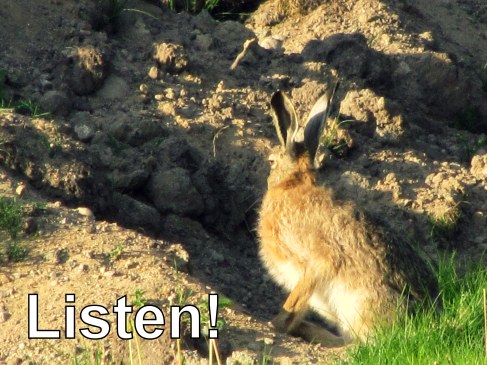

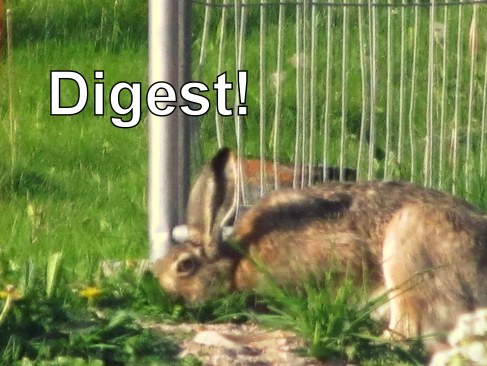


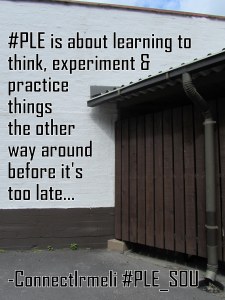
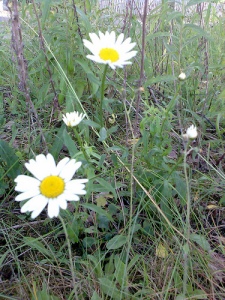 Pic: Irmeli Aro’s
Pic: Irmeli Aro’s  Pic: Irmeli Aro’s
Pic: Irmeli Aro’s 



